Jewish and Latter-day Saint Leaders Find Common Ground on Doctrine in New York
Contributed By Sarah Jane Weaver, Church News editor
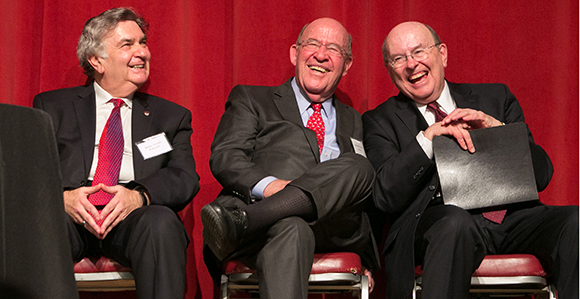
Rabbi Joseph Potasnik; Robert Abrams, the former New York attorney general; and Elder Quentin L. Cook of the Quorum of the Twelve Apostles participate in meeting sponsored by the New York Latter-day Saint Professional Association on December 18. Photo by Nicole Ekberg.
After lauding the service of his friend Rabbi Joseph Potasnik, Elder Quentin L. Cook spoke in New York City on December 18 about the common ground that exists between the Latter-day Saint and Jewish communities.
“We share with our Jewish friends the concern for oppressed people and those who face special challenges,” said Elder Cook of the Quorum of the Twelve Apostles.
Speaking to the New York Latter-day Saint Professional Association, Elder Cook offered a tribute to Rabbi Potasnik, executive vice president of the New York Board of Rabbis who was honored with the event’s Visionary Leadership Award.
During the event, held in the historic Riverside Chapel in Manhattan and attended by a capacity crowd of more than 400, Elder Cook addressed some of the unique Church doctrine that ties Latter-day Saints closely to those of the Jewish faith.
Elder Cook also praised the Latter-day Saint Professional Association, which has been “a bridge and outreach to prominent leaders of different faiths,” he said.
There have been numerous personal relationships with Jews and Latter-day Saints that have been strong and rewarding over a long period of time, said Elder Cook.
Earlier in his life when he completed his law school education at Stanford University, Elder Cook joined a law firm where the managing partner was of Jewish descent and became his mentor and dear friend. A significant number of the friends of the Cook children, as they were growing up in the San Francisco Bay area, were also of Jewish descent. “I’m sure if we asked those of you who are here tonight, you could echo those same kinds of rewarding relationships,” he said.
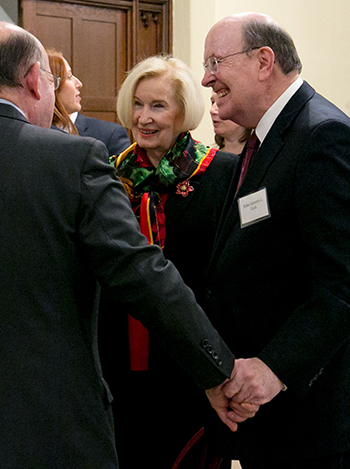
Elder Quentin L. Cook and his wife, Sister Mary G. Cook, visit with guests after the New York Latter-day Saint Professional Association dinner, held in the historic Riverside Chapel in Manhattan on December 18. Photo by Nicole Ekberg.
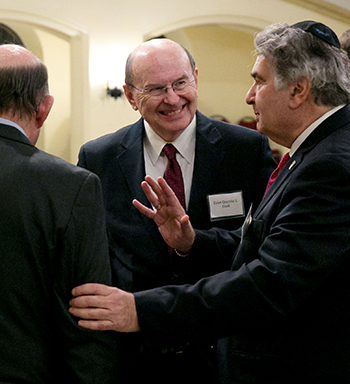
Robert Abrams, the former New York attorney general; Elder Quentin L. Cook of the Quorum of the Twelve Apostles; and Rabbi Joseph Potasnik participate in meeting sponsored by the New York Latter-day Saint Professional Association on December 18. Photo by Nicole Ekberg.
A more institutional—or “leader-to-leader” relationship between the faiths—is more recent, said Elder Cook. “I believe one of the reasons this did not occur earlier is that our principal centers of influence are primarily in different parts of the United States.”
Interestingly, in the United States, members of the Jewish faith and members of The Church of Jesus Christ of Latter-day Saints each have a population of between 6 to 7 million. “The center of Jewish influence is New York City and the surrounding East Coast area, where there are approximately 3 million Jews; the center of The Church of Jesus Christ of Latter-day Saints’ influence is in Utah and the surrounding states, where there are approximately 3 million Latter-day Saint members.”
Inherent in this geographical distance was the potential for misunderstandings even with respect to actions that were meant to be respectful and kind, said Elder Cook.
In 2009 Robert Abrams, the former New York attorney general who first introduced Elder Cook to Rabbi Potasnik, organized a delegation of prominent Jewish leaders from New York to visit with Church leaders in Salt Lake City. “Rabbi Joseph Potasnik was at the center of that group of Jewish leaders because of the universal respect that he has attained both in the Jewish community and the greater New York, East Coast, community at large,” said Elder Cook. “I was one of the members of The Church of Jesus Christ of Latter-day Saints who had the privilege of interacting with that group of rabbis in Salt Lake City and hosting them at the Oquirrh Mountain temple open house.”
Elder Cook asked Abrams to participate in the introduction of Rabbi Potasnik, noting that each time he brought the two faiths together he chose Rabbi Potasnik as a major centerpiece in the relationship. He also asked Ambassador Dani Dayan, Consul General of Israel in New York, to participate in the introduction of Rabbi Potasnik.
Accompanied by Elder Jack N. Gerard, General Authority Seventy, and Elder David L. Buckner, an Area Seventy, during his visit to New York, Elder Cook also visited the American Jewish Committee headquarters and met with senior leadership of the global Jewish advocacy organization. He also met with Ambassador Dayan in his office. Ambassador Dayan later tweeted about the meeting. “We will continue to enhance the friendship between the Church and the State of Israel,” he wrote. And Elder Cook also enjoyed time with Cardinal Timothy Dolan, who was honored by the Latter-day Saint Professional Association two years ago.
Elder Cook said when he became acquainted with Rabbi Potasnik he understood why he is so well respected. “We enjoyed marvelous conversations on important issues. I found him to be respectful even when we were not in total agreement.”
Sharing a media account from the Times of Israel, Elder Cook spoke about Rabbi Potasnik’s role as chaplain for the New York Fire Department. On September 11, 2001, Rabbi Potasnik arrived at Ground Zero 32 minutes after the North Tower collapsed, and he returned every day for a month. “Being there all those days, all those weeks; it was a family of faiths,” Rabbi Potasnik was reported as saying. “We decided to have a Christmas tree and a menorah. Ground Zero became a place where death taught us love.”
Elder Cook said Rabbi Potasnik is known for building bridges between different faith groups; and widely recognized for his efforts to promote interdenominational and interfaith dialogue.
“I think if you’re truly religious, you realize it’s not enough to pray for your own people, “ said Rabbi Potasnik. “It’s not enough to pray for peace for your own community.”
Elder Cook said his personal relationship with Rabbi Potasnik was greatly enhanced when Abrams suggested “that a commemoration of Orson Hyde’s 1841 dedication of the Holy Land as a gathering place for Jewish people would further unite both of our communities.”
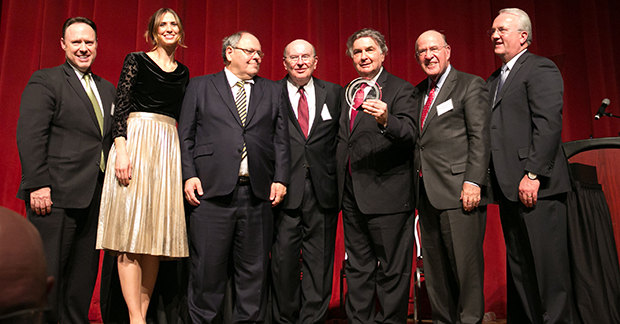
Rabbi Joseph Potasnik receives the Visionary Leadership Award from the New York Latter-day Saint Professional Association on December 18, 2018. From left: Elder David Buckner, Area Seventy; Andrea Combs, local Latter-day Saint representative; Ambassador Dani Dayan; Elder Quentin L. Cook; Rabbi Joseph Potasnik; former New York attorney general Robert Abrams and Elder Jack N. Gerard, General Authority Seventy. Photo by Nicole Ekberg.
Explaining the significance of that event, Elder Cook shared Church history and doctrine.
Elder Cook spoke of the 1836 dedicatory prayer for the Kirtland Temple, set forth in Doctrine and Covenants 109. “One aspect of the Kirtland dedicatory prayer is of particular significance to the Jewish people. It is faith promoting and evidence of Joseph Smith’s prophetic mission.”
Quoting Doctrine and Covenants 109:62, Elder Cook explained that Joseph Smith taught the principle of the return of the Jews to the Holy Land. “This occurred 60 years before the beginning of a Zionist movement and 82 years before the first governmental action (The Balfour Declaration in Great Britain), which declared that Britain favored, ‘the establishment in Palestine of a homeland for the Jewish people.’ The declaration also indicated that the rights of non-Jewish communities, in Palestine, should not be prejudice.”

Robert Abrams, the former New York attorney general; Elder Quentin L. Cook of the Quorum of the Twelve Apostles; and Rabbi Joseph Potasnik, executive vice president of the New York Board of Rabbis, participate in a meeting sponsored by the New York Latter-day Saint Professional Association on December 18, 2018.Photo by Nicole Ekberg.
Subsequent to the Kirtland Temple dedicatory prayer, two events occurred in furtherance of Joseph’s dedicatory prayer, said Elder Cook.
First, in 1840, Elder Parley P. Pratt wrote the lyrics for the hymn, “The Morning Breaks,” the “quintessential hymn of the Restoration.” Elder Pratt wrote in verse three, “The Gentile fullness now comes in, And Israel’s blessings are at hand. Lo, Judah’s remnant, cleansed from sin, Shall in their promised Canaan stand.”
Second, Elder Orson Hyde was assigned by the Prophet Joseph Smith to dedicate Jerusalem for the return of the Jews and left for Palestine early in 1841. On Sunday, October 24, 1841, Elder Hyde “knelt on the Mount of Olives and dedicated the Holy Land for the gathering of the Jews and of Israel as their ancient inheritance.”
The 175th anniversary of Orson Hyde’s dedication of Jerusalem inspired a joint delegation of Jewish leaders and Church leaders to go to Jerusalem. Elder Cook and Elder Jeffrey R. Holland of the Quorum of the Twelve represented the Church at that event. (See related story.)
An extraordinary effort was made for the contingent to secure an audience with Prime Minister Benjamin Netanyahu, said Elder Cook.
“What has become clear on these occasions, including tonight, is the common ground that exists between the Latter-day Saint community and the Jewish community,” said Elder Cook.
While there is no analogue to the Holocaust, the extermination order issued by Missouri governor, Lilburn Boggs, in 1838 caused atrocities, he added. “But even with a difficult shared past, the relationship between members of The Church of Jesus Christ of Latter-day Saints and the Jewish community is based on positive and uplifting approaches that bless everyone.”
Robert Abrams, he added, expressed this beautifully when in Jerusalem:
“Each has a fundamental focus on family, each place a very high value on education, each has a strong commitment to charitable giving, each demonstrates humanitarian concern and response when there are international catastrophes such as earthquakes, hurricanes and tsunamis around the globe, each has a history of disproportionate success due to ability, hard work and determination and each has been subjected to fierce persecution and prejudice.”
Concluding, Elder Cook said, “I believe that expresses the commonality in an eloquent way. … We treasure our friendship.”

Elder Jack Gerard, a General Authority Seventy, participates in meeting sponsored by the New York Latter-day Saint Professional Association on December 18. Photo by Nicole Ekberg.
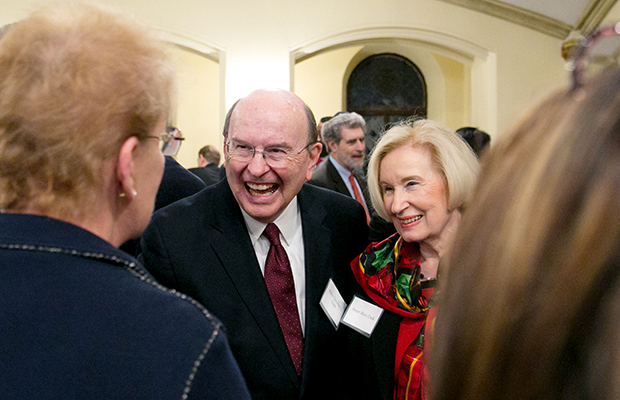
Elder Quentin L. Cook and his wife, Sister Mary G. Cook, visit with guests after the New York Latter-day Saint Professional Association dinner, held in the historic Riverside Chapel in Manhattan on December 18.
Photo by Nicole Ekberg.
